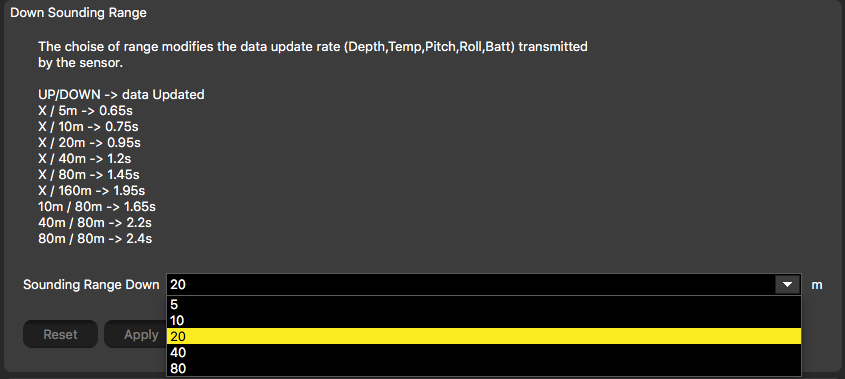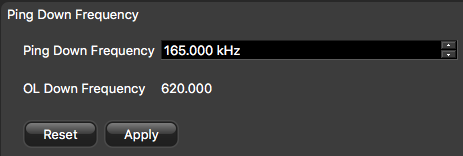Configuring the Uplink and Down Settings
You can configure different settings for uplink and down soundings.
Before you begin
About this task
Remember: Always click Apply after you change a setting and make sure there is a
green check mark  .
.
Procedure
Click the tab Trawl Explorer.


Uplink
Procedure
From TE Uplink
Frequency, enter a frequency
for the signal toward the vessel.


Important: This parameter must be the same in the sensor settings
in Scala2.
Down Sounding
Procedure
-
For Door Sounder with target strength only: in NBTE Setup Options you
can select Down 1 + Down 2 if you want to
compare two different settings on the down sounding (for example, two
ping lengths or 2 frequencies). The sensor will send two consecutive
pings toward down direction.

-
From Down Sounding Range, select the range according to how many meters
you want to see under the sensor.

Note: Range influences the display of echogram images. The smaller the range, the shorter the listening time and the better the quality of images. But if you set a bigger range, data arrives slower which results in poorer image quality.Note: Door Sounder with target strength calibration: The range of the down sounding can automatically change to 20 meters if the distance to the bottom becomes lower than 20 meters and if you entered a trawl opening lower than 20 m. See next step to activate this feature.Important: This parameter must be the same in the sensor settings in Scala2. -
Door Sounder with target strength
calibration: From Trawl Opening,
enter 0. The opening needs to be lower than 20 m to have the autorange
feature. Otherwise this setting is not useful for a door
sensor.

Important: If you use Down 1 + Down 2 sounding mode, enter 20 m or more to deactivate the autorange feature because it creates wrong data on the echogram. -
From Ping Down Length, enter a pulse length. Choose a pulse length according to the distance at which you need
to detect the bottom. (the
longer the pulse, the further you can see, but with a lower
resolution):

- Detection between 20 cm and 2 m: enter 0.1 ms
- Detection between 50 cm and 160 m (V2: up to 80 m): enter 0.4 ms .
Note: The maximum detection depth depends on ping frequency and type of bottom. The lower the ping frequency is, the longer the detection depth is. -
From Ping Down
Frequency, enter a frequency for the
down sounding. Make sure to put a minimum
distance of 20 kHz between starboard and clump frequencies.

Important: Frequency needs to be between 120-210 kHz for a Door Sounder.Important: Do not change ping frequency on a V3 sensor or it will have to be returned to a Marport sales' office for target strength calibration.
Target Strength
Procedure
From Down TVG Mode, select the appropriate
TVG (Time Variable Gain) mode. See About Time Variable Gain for more
information.
TVG parameters
for Door Sounder with target strength
calibration:
Select 20 log to see the bottom in the same color,
whatever its distance from the sensor.


TVG parameters
for Door Sounder V1:

- From TVG Coefficient, enter 0.500 to see the bottom in the same color, whatever its distance from the sensor.
- From Attenuator Coefficient, enter 25.
- Leave VCO Coefficient default settings at 3.
